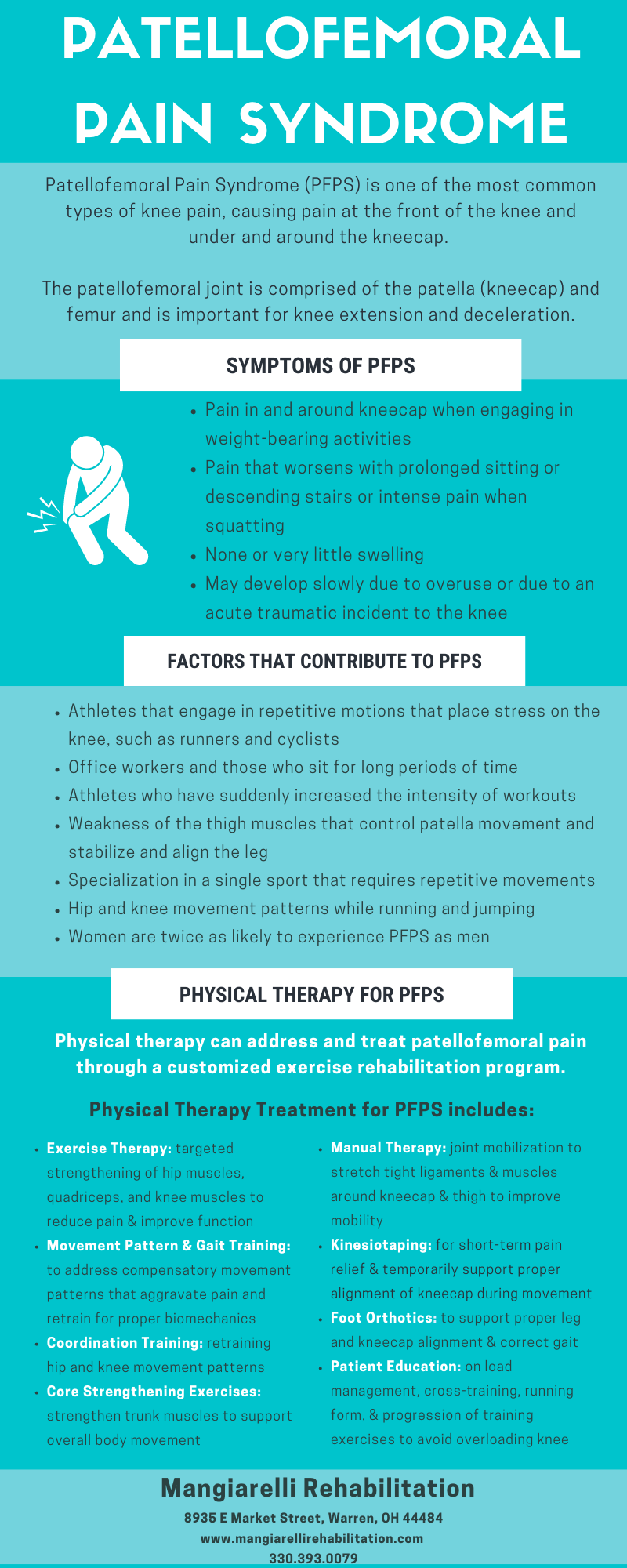Patellofemoral Pain Syndrome [Infographic]
Patellofemoral pain syndrome (PFPS) is one of the most common types of knee pain that causes pain at the front of the knee and under and around the kneecap. Annually, 23% of the general population experiences PFPS, and 29% of adolescents do, with female adolescent athletes at a higher risk of developing the condition. PFPS is known as runner’s knee and often occurs in athletes and runners following a sudden increase and intensity in training.
PFPS involves dysfunction at the patellofemoral joint, which consists of the patella (the kneecap) and the femur. This joint is critical for knee extension and deceleration and is stabilized by the quadriceps, patellar tendon, and a series of ligaments.
There are several risk factors for developing PFPS, which include weakness in the thigh muscles and quadriceps; hip and knee movements when running or jumping; engaging in repetitive movements like running and squatting; specialization in one sport that requires repetitive movements; and the female sex. Women are twice as likely as men to experience PFPS due to the anatomical structure of women’s legs.
Symptoms of PFPS include pain in and around the kneecap, particularly when engaging in weight-bearing activities; pain that worsens with prolonged sitting or intense pain when squatting; and very little swelling. PFPS can develop over time due to overuse or due to an acute traumatic incident to the knee.
Exercise therapy is considered the key treatment protocol for the successful management and rehabilitation of PFPS. At Mangiarelli Rehabilitation, our therapists design a customized therapeutic exercise program to reduce pain and improve function. The exercise program targets the hip muscles, quadriceps, and knee muscles for strengthening as well as ankle strengthening to correct any imbalances that contribute to PFPS and core strengthening for greater trunk stability. Stretching exercises are also incorporated to address limited range of motion in the hip, knee, and ankle.
Exercise therapy is often done in conjunction with movement and gait training and manual therapy. Movement, coordination, and gait training retrain movement in the hips and knees to address compensatory movement patterns to reduce stress on the patellofemoral joint and ensure proper biomechanics when walking, running, and jumping. Manual therapy involves joint mobilizations to stretch tight ligaments and muscles around the kneecap and thigh to improve mobility in the knee and leg and reduce pain.
Kinesiotaping and foot orthotics are also used to ensure proper alignment of the kneecap during movement and support correct gait. The therapist also educates the patient on load management, running form, and progression of training to avoid overloading and re-injuring the knee.
Patellofemoral pain syndrome is a common knee condition that can limit your daily activities and ability to perform in your sport. Don’t wait to treat PFPS. Work with a physical therapist to address pain and regain function to return to your activities and sport with greater strength and mobility!
